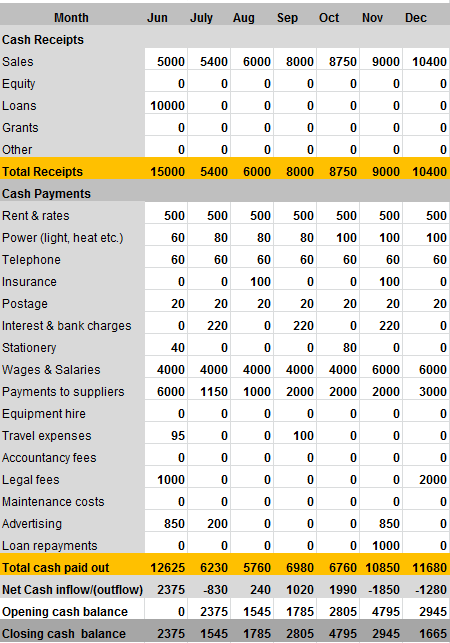How to Prepare a Cash Flow Forecast
Cash flow forecast is a pretty important topic and you’ll have come across some of the previous stuff we published. In fact, we wrote a whole guide about it. Why have you written so much about cash flow? You might ask that question, and the answer is because it is vital to the survival of all businesses. We think that’s a pretty important topic so we’re covering it in as much detail as possible.
A quick reminder, cash flow is the movement of money into and out of your business. It’s critical that you always have more money coming into your business than you do going out, so that the business can pay the bills it owes and continue to trade.
Cash flow forecast
In this post we’re going to talk about how to prepare a cash flow forecast. Just like most good things start with a good plan, a good cash flow forecast is the foundation of good cash flow management. Doing regular forecasts will let you see any sticky financial situations ahead of time and give you the necessary notice to react. We can’t stress how important that is, cash flow forecasts could literally save your business. So how do we prepare one?
The first thing you have to do is pick the time period you want to forecast for and break that time down into months. We recommend doing regular forecasts for a period of a few months. Things change regularly in business and a forecast that you prepared 12 months ago probably looks at lot different to what is actually happening now. Once you have decided on your time period we can begin to layout our forecast.
You can use simple spreadsheet software such as Excel to produce a forecast in a matter of minutes. Your cash flow forecast will show estimates of the money coming in and the money going out for each month leaving us with the money we have left over. We want the estimates that we use to produce our forecast to be as accurate as possible.
Below is an example forecast that has been put together for 6 months. Have a look through it before we outline the details underneath.

We can see in our example that we have prepared the forecast for 6 months from June to December. The first section is called Cash Receipts. This section is used to determine how much money we should have coming in to our business over the next few months. Our primary means of receiving money in is through sales. You should be able to input reliable estimates for your sales figures over the coming months based on historic figures or invoices you may already sent out that aren’t paid yet.
Apart from sales we may receive money into our business by other means, such as equity (investment), loans or grants. In this example, this business is a start up and the owner will take out a loan for 10,000 from the bank in June to help with set up costs. That’s why we can see it recorded as a cash receipt in the first month of our forecast, because that money will come into the business. The owner has estimated sales figures for the next 6 months, showing a gradual increase as the business establishes itself.
Our Total Receipts (shown in yellow here) is the sum of all the money the business can expect to receive for that month. Our next section, called Cash Payments, will list all of the outgoings we expect the business to have in the coming months. Some of these such as telephone costs, may be a flat monthly bill. On the other hand we may have one off costs that we need to be aware of such as legal fees when the company is first set up or paying our accountant at the end of the financial year.
Generally, wages will be the largest, consistent outgoing from your business. Purchases you make from suppliers will also play a big role in your outgoings too. In our example we can see that a lot of supplier payments are made in June as the business owner buys in what he needs to launch the business and start selling. It’s also estimated that they will be higher in December as more may be required to meet the demand of the Christmas period.
Adding up all of the outgoings we expect to have a month results in our Total Cash Paid Out (shown in yellow). By subtracting this from our Total Cash Receipts we can see exactly how much cash we have left in the business after each month called a Net Cash Inflow, or potentially how much of a cash deficit we could have for that month known as a Net Cash Outflow. Having a net cash outflow for an extended period of time means trouble for our business as it will have to rely on the cash reserves we’ve already built up over the previous months to survive.
In our example we can see a net cash outflow for November and December. The wages are higher than they were previously as the business owner wishes to hire another staff member in the run up to Christmas. However, it appears that business can’t afford it as it results in a net cash outflow and the business is surviving on the opening cash balance for those months. The business owner may have to reconsider their intention to hire more staff.
So, what is the Opening Cash Balance? Our opening balance is how much cash the business has on hand at the start of each month. Usually this is what the balance of the business bank account(s) is. As you can see in our example, our opening cash balance is 0 because this is a brand new business. However, in July, our opening cash balance is the Closing Cash Balance from the previous month, and so on for the rest of the months in the year. To get our closing cash balance for a given month we just add our opening cash balance to the net cash inflow/outflow. This gives us a good estimate of how much money the business has at its disposal at the end of the month.
So what does your cash flow forecast say about your business? Why not prepare one and make sure you get the best possible picture of the financial health of your business.

